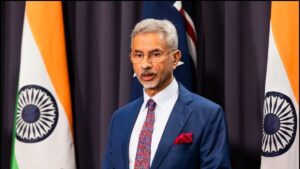‘Weight’ & Watch: Indian Pharma Set To Enter Ozempic, Wegovy Market, But Swift Price Crash Unlikely

Last Updated:
The Indian market for GLP-1 drugs has not fully opened yet, mainly due to the unavailability of these leading brands and affordability issues. But even if Ozempic and other popular versions were available in India, they would have remained out of reach for many due…Read More
It’s important to remember that India is known as the ‘diabetes capital of the world’, and the latest Economic Survey report reveals that the rate of adult obesity in the country has more than tripled. Representational image
Indian drugmakers are preparing for the launch of copycat weight-loss drugs as the world moves towards the patent expiry of Novo Nordisk’s blockbuster brands Ozempic and Wegovy.
The Danish firm’s patents for semaglutide, the active pharmaceutical ingredient in its star brands, will start expiring in Asia (including India) and Africa in 2026 and in the US in 2030. While all eyes are on the Indian industry – known for its ability to produce generic drugs at a fraction of the cost – to cater to the soaring yet unmet demand for anti-obesity and anti-diabetic drugs, driving sales through price war won’t be easy this time.
Globally the demand for weight-loss drugs, specifically the glucagon-like peptide-1 (GLP-1) class of medications is “exploding”, experts told News18. The drug is used to treat type 2 diabetes and obesity and it works by mimicking the effects of the body’s natural hormone, GLP-1, which helps to reduce appetite, slow digestion, boost insulin production, and decrease the amount of sugar produced by the liver.
Health experts eagerly anticipate the launch of these drugs in India to meet the rising demand. It’s important to remember that India is known as the “diabetes capital of the world”, and the latest Economic Survey report reveals that the rate of adult obesity in the country has more than tripled.
Popular endocrinologist Dr Anoop Misra told News18 that semaglutide and other advanced drugs in this class are “impactful, offering a range of significant health benefits”.
“Their use is expected to rise sharply,” said Misra, who is chairman of Fortis C-Doc Hospital for Diabetes and Allied Sciences. “However, cost remains a significant concern, and the availability of affordable alternatives, such as generics for Ozempic, is crucial for India where obesity and diabetes are on the rise.”
As research progresses, Misra said, “We anticipate even more potent medications on the horizon that could offer substantial benefits for individuals with severe obesity.”
Misra’s expectations align with the industry’s strategy—to introduce improved medicines that are more effective than current options like Ozempic but at a significantly lower cost.
Will loss of patent bring prices down?
The Indian market for GLP-1 drugs is yet to open up fully due to the unavailability of these top brands, with affordability also being a significant barrier. It means that while Ozempic or many other top-selling versions are not in India and even if they were, they could have been unaffordable for many Indians.
According to Novo Nordisk’s website, the price of an Ozempic pen (0.25 or 0.5 mg) is $968.52, which translates to over Rs 81,000. But, the local drug dealers claim to import and sell the injection for Rs 20,000 per shot.
However, the market for this category may not move as it does for other generic drugs where the price of generic drugs falls dramatically. In fact, experts cautioned that moving further, the price of the copycat version of the majority of GLP-1 class drugs or semaglutide may not crash heavily. The reason is that these drugs follow a complex manufacturing process very similar to making biological products.
To put it in perspective, semaglutide is a polypeptide and was originally classified as a biologic. However, under the FDA’s newly revised definition, it is no longer classified as a biologic because it contains fewer than 40 amino acids.
Vishal Manchanda, pharma analyst at financial services firm Systematix, told News18 that the category registered annual sales of $50 billion this year which is almost twice the size of the Indian pharmaceutical industry.
“Generally, we expect prices to crash in the range of 80 to 90% after the drug loses its patent, but in this case, we must also consider that making this class of drugs is complex. Therefore, it remains to be seen whether the desired price reduction can be achieved or not.”
Currently, two innovators are dominating the $50 billion market : Novo Nordisk’s Ozempic or Wegovy (Semaglutide) and Eli Lilly’s Mounjaro/Zepbound (Tirzepatide).
On Wednesday, Novo Nordisk said that it has tripled Wegovy production over the last three years and will continue to ramp up at the same pace, but still, it is unable to serve the demand. “We still have a situation where there are far more patients who would like to have the treatment than what both Eli Lilly and we can supply,” CEO Lars Fruergaard Jorgensen told Reuters. This shows the huge demand and gap in supply.
Manchanda believes that in the coming two to three years, multiple other innovator brands will emerge in the global market with eight to ten brands coming from large credible players. “This is when the economics is going to change as the demand shortages will be plugged. People in developed markets will get even better options than existing ones and developing markets like India (which are being ignored by innovators) will gain attention.”
In short, it’s expected that the upcoming drugs are likely to have a better profile in terms of quicker weight loss and convenient dosage (such as oral pills instead of injections).
“Hence, in a few years from now, emerging markets (including India) will have multiple GLP-1 options to choose from,” Manchanda predicts. “Also, semaglutide generics will become available…While the price of semaglutide is expected to fall once generics are launched, it remains to be seen whether the reduction will be significant enough to greatly expand access or not.”
Indian pharma developing semaglutide, other GLP-1 drugs
Wegovy and Ozempic drove Novo Nordisk to record bumper sales since the launch. In fact, the success story has turned the Danish drugmaker into Europe’s most valuable firm. Estimates peg that the company’s market value of about $570 billion is more than its home country, Denmark’s, annual GDP.
While Novo Nordisk declines to comment on its plan to launch Ozempic or Wegovy in India (in an email sent by News18), it’s obvious that all major Indian generic manufacturers are closely monitoring the upcoming expiry of Novo Nordisk’s exclusivity on GLP-1 drugs.
Manchanda said that in India, at least five to six players are working on developing the generic versions including Sun Pharma, Biocon (which already has large-scale peptide drug-making experience), Dr Reddy’s, Zydus, Natco, Shilpa Medicare, and Aurobindo Pharma.
Furthermore, Novo Nordisk may also not step back once the drug’s patent expires. The company may lower its price and continue to compete in the market. “Majority of Indian firms have capabilities to manufacture peptides and they can certainly manufacture this complex category. But we also expect the innovator Novo Nordisk to compete with generic players and chase a majority share,” Manchanda added.
On Tuesday, Dr Reddy’s Laboratories announced in an investor call that the company aims to have about “15 GLP-1 drugs” to treat obesity and diabetes, in its portfolio with various timelines.
In October, last year, the company received the nod for conducting a bioequivalence study for Ozempic (semaglutide injection) from the Drugs Controller General of India (DCGI) after it sought a waiver of the phase-III clinical trial of the drug and its market authorisation. It aims to bring in the generic version as soon as the patent expires.
A company spokesperson told News18 that while the product is under patent right now, Dr Reddy’s Labs “will definitely participate in the opportunity but we will be part of the generics entry when the patent expires”.
Bengaluru-based Biocon – which is known for its expertise in developing complex biosimilars – has become the first company to win UK authorisation to offer a generic version of Novo Nordisk’s other popular GLP-1 category drug liraglutide sold under the brand name Saxenda. The firm told the Financial Times that it is ready to launch sales by November.
In an interview with the Financial Times, Siddharth Mittal, chief executive officer, Biocon Limited, predicted, “When the generics come in there will be a huge price war…There is a huge demand for these drugs at the right price.”
Biocon’s spokesperson did not respond to News18’s request for comment seeking more information on its plans to launch anti-obesity drugs in India.
What’s cooking in Indian drugmakers’ research labs?
India’s top drugmaker, Sun Pharma, is working on developing the GLP-1 category drug Utreglutide. In June, it announced the results from the study showing significant weight loss, glucose-metabolic and lipid-lowering efficacy.
Another Mumbai-based drugmaker, Cipla, is also preparing to launch GLP-1 drugs in India, the US, and other emerging markets.
“GLP-1 for diabetes and obesity is a very big transformation, equivalent to statins for cholesterol control,” Umang Vohra, the company’s global CEO, said in a press briefing in January this year. “And I would like to believe there are 100 million diabetics (patients) in this country (India) and there are several that are not diagnosed. And I think if we were to even cover 20 or 25% of that population by using GLP-1, it’s going to be a very significant opportunity.”
He said that “Cipla will be looking (at hopping on the opportunity) for India, emerging markets, and the US [for semaglutide]. We may not be the first wave launcher in the US, but we have plans.”
Natco and Mylan have also collaborated on the development of generic Ozempic products.
Not only top pharma companies are keen to manufacture but the central government is also gearing up to make GLP-1 drugs under the flagship production-linked incentive (PLI) scheme.
Arunish Chawla, secretary, department of pharmaceuticals (DoP), told reporters in June that “the local pharmaceutical industry is already working on producing these drugs here after the patents expire around 2026″.
Without divulging details of which companies are working on it (citing competition sensitivity), he said: “Work has already begun on the same and soon GLP-1RA drugs will be made in India under the PLI scheme.”
While increased competition is certainly good news for patients, the real winner will likely be the company that offers the lowest cost and can meet the market’s demands on a large scale.



